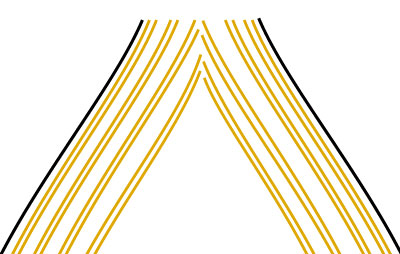Last week, I showed you the finished goldwork edge around the inside cinquefoil on the Medallion Project. One recurring question from that article was how to achieve the sharp corners with the couched Japanese gold thread. You know, that was a problematic part for me, too!
The easiest path to take when couching the gold would have been to work in two continuous lengths of the Japanese gold, side-by-side, so that the threads only had to be plunged twice while filling that whole area – once at the beginning of the couching and once when the whole outline around the cinquefoil was filled. As efficient and dreamily pleasant as it would have been to not have to stop to plunge threads, the sharp angles at each corner would’ve been lost with that approach.
The only approach that would keep the integrity of the design and achieve the effect that I wanted to achieve was to plunge the ends of the gold thread at every angle – a process that made sense but took decidedly more time.
Today, we’ll look at how I took the sharp corners on the cinquefoil shape, using Japanese gold thread.

This is the gold that I’m talking about – that wider band of gold in a scalloped, five-petaled shape that surrounds the inside section of the medallion. In fact, one reader (Jenn) commented that this gold outline looks like a bevel, and that’s exactly what I was trying to achieve – a kind of bevelled edge around the cinquefoil shape, so that the center seemed to sit on top of the rest of the design. So I was thrilled to the moon to see Jenn’s comment. Whew! I wasn’t the only one who saw the bevel. (It’s always easier to see what you want to see – the question is, do others see the same thing?!)

So, to really get across that whole “bevel” idea, I knew the sharp angles where the scallops meet would have to be maintained and that a hint of a line along the angle would have to be somewhat visible. But with Japanese gold, it is pretty difficult to pinch a really sharp (acute) angle and keep that angle with each subsequent line of gold. With smooth passing thread, it’s a bit easier, because smooth passing is wire wrapped around a core. Japanese gold is paper wrapped around a core.
Plunging the gold threads at each corner guaranteed that the angle would be maintained and the area would be filled without any “softening” of the angle, and it would also create a somewhat visible line at each angle.

The gold threads are couched in pairs. At each tip of the angle, I plunged the pair of threads in such a way that they alternated placement with the pair of threads that would butt up next to them in the next scallop. The drawing above illustrates the placement of the threads when plunging them.

You can see the same idea in the drawing above, which was from the Goldwork Pomegranate project, where I explained how to do the same thing with smooth passing thread. In that article, I explain how to plunge the threads using a plunging needle. You can also plunge threads to the back using a plunging lasso. In this project, I find that the needle works better than the lasso, because the area is small and tight.

So, by slightly alternating the placement of the pair of gold threads along the angle, plunging them so they sort of “miter” together, I was able to maintain a very sharp angle and a somewhat visible “line” where the threads meet, to help enhance that whole sense of a “beveled” gold edge around the scalloped shape of the cinquefoil.

This photo, though somewhat sloppily taken, might give a better sense of the “bevel.” Do you see it?
That’s it then. That’s how I worked the sharp angles with the Japanese gold thread. You can apply these concepts to any of your goldwork projects, too – they certainly aren’t specific to this project alone!
If you’d like to see the progress of the Medallion Project step-by-step and pick up other goldwork or silk embroidery tips along the way, feel free to visit the Medallion Project Index, where you’ll find all the articles relating to this project arranged chronologically.
Tomorrow – let’s a play a bit with Stitch Play! It’s much more relaxing!








